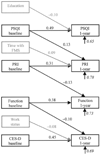Sleep disturbances in fibromyalgia syndrome: relationship to pain and depression
- PMID: 18576297
- PMCID: PMC3691959
- DOI: 10.1002/art.23828
Sleep disturbances in fibromyalgia syndrome: relationship to pain and depression
Abstract
Objective: This study is an examination of sleep, pain, depression, and physical functioning at baseline and 1-year followup among patients with fibromyalgia syndrome (FMS). Although it is clear that these symptoms are prevalent among FMS patients and that they are related, the direction of the relationship is unclear. We sought to identify and report sleep problems in this population and to examine their relationship to pain, depression, and physical functioning.
Methods: Patients diagnosed with fibromyalgia were recruited from a Southern California health maintenance organization and evaluated according to American College of Rheumatology criteria in the research laboratory. Six hundred patients completed the baseline assessment and 492 completed the 1-year assessment. Measures included the Center for Epidemiologic Studies Depression Scale, the McGill Pain Questionnaire, the Pittsburgh Sleep Quality Index, and the Fibromyalgia Impact Questionnaire.
Results: The majority of the sample (96% at baseline and 94.7% at 1 year) scored within the range of problem sleepers. Path analyses examined the impact of baseline values on 1-year values for each of the 4 variables. No variable of interest predicted sleep, sleep predicted pain (beta = 0.13), pain predicted physical functioning (beta = -0.13), and physical functioning predicted depression (beta = -0.10).
Conclusion: These findings highlight the high prevalence of sleep problems in this population and suggest that they play a critical role in exacerbating FMS symptoms. Furthermore, they support limited existing findings that sleep predicts subsequent pain in this population, but also extend the literature, suggesting that sleep may be related to depression through pain and physical functioning.
Figures

References
-
- Harding S. Sleep in fibromyalgia patients: subjective and objective findings. Am J Med Sci. 1998;315:367–376. - PubMed
-
- Shaver JL, Lentz M, Landis CA, Heitkemper MM, Buchwald DS, Woods NF. Sleep, psychological distress, and stress arousal in women with fibromyalgia. Res Nurs Health. 1997;20:247–257. - PubMed
-
- Anch AM, Lue FA, MacLean AW, Moldofsky H. Sleep physiology and psychological aspects of the fibrositis (fibromyalgia) syndrome. Can J Psychol. 1991;45:179–184. - PubMed
-
- Korszun A, Young EA, Engleberg NC, Brucksch CB, Greden JF, Crofford LA. Use of actigraphy for monitoring sleep and activity levels in patients with fibromyalgia and depression. J Psychosom Res. 2002;52:439–443. - PubMed
-
- Melzack R, Loeser JD. Phantom body pain in paraplegics: evidence for a central “pattern generating mechanism” for pain. Pain. 1978;4:195–210. - PubMed
Publication types
MeSH terms
Grants and funding
LinkOut - more resources
Full Text Sources
Other Literature Sources
Medical
Miscellaneous

